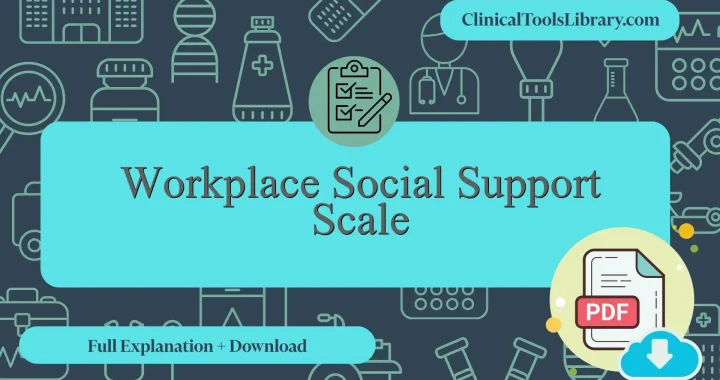In this article, we explain everything you need to know about the Workplace Social Support Scale. We will cover the aspects it evaluates, the target population, a detailed step-by-step explanation, and how to interpret its results. Additionally, we will dive into the scientific evidence supporting this tool (diagnostic sensitivity and specificity) in clinical assessment. You will also find official and unofficial sources available for download in PDF format.
What does the Workplace Social Support Scale assess?
The Workplace Social Support Scale is a validated instrument designed to measure the perceived availability and quality of support that employees receive from colleagues and supervisors in a professional setting. Its main purpose is to evaluate the extent to which individuals feel supported in managing occupational stressors, which is critical for reducing the risk of psychosocial strain and improving overall mental health outcomes. This scale typically assesses dimensions such as emotional, informational, and instrumental support within the workplace environment. Various versions, including the Brief Social Support Scale and the Multidimensional Social Support Scale, provide comprehensive evaluations to guide organizational interventions aimed at fostering a supportive work atmosphere. Access to the Workplace Social Support Scale PDF and related resources like the Social support Scale Questionnaire or the Perceived Social Support Scale PDF enables practitioners to implement evidence-based assessments in occupational health research and clinical practice.
For which type of patients or populations is the Workplace Social Support Scale intended?
The Workplace Social Support Scale is principally indicated for individuals experiencing occupational stress or those diagnosed with stress-related disorders such as adjustment disorders and burnout syndrome. It is most useful in clinical contexts where evaluation of psychosocial factors influencing employee well-being and productivity is essential, particularly within mental health and occupational health settings. This tool facilitates the assessment of perceived emotional, instrumental, and informational support available in the work environment, which is critical for tailoring interventions aimed at reducing job strain and improving coping strategies. Clinicians often utilize the Social Support Questionnaire 12 items PDF or the Perceived Social Support Scale PDF alongside this instrument to gain a comprehensive view of a patient’s support network, ensuring a multidimensional approach in both assessment and treatment planning.
Step-by-Step Explanation of the Workplace Social Support Scale
The Workplace Social Support Scale consists of 12 items designed to assess perceived social support from supervisors and coworkers. Each item employs a 5-point Likert scale, ranging from “Strongly Disagree” (1) to “Strongly Agree” (5), allowing respondents to quantify the degree of support they experience. The questions focus on various aspects of emotional and practical support, such as availability of assistance, encouragement, and understanding related to workplace stressors. Administrators should instruct participants to consider their recent workplace interactions while responding, ensuring that answers reflect current perceptions. The scale’s scores are computed by summing responses for supervisor and coworker subscales separately, facilitating targeted interventions for issues like work-related stress and burnout.
Workplace Social Support Scale PDF: Original & English Versions for Accurate Assessment
Downloadable resources featuring both the original and English versions of the Workplace Social Support Scale PDF are provided below to facilitate accurate assessment and research. These files are available in PDF format, ensuring ease of access and compatibility across various platforms. Utilizing these validated instruments allows healthcare professionals to measure perceived support within occupational settings, thereby aiding in the identification of factors that influence employee well-being and resilience against stress-related conditions such as anxiety and depression.
How to interpret the results of the Workplace Social Support Scale?
Interpreting the results of the Workplace Social Support Scale involves comparing the total score, which typically ranges from 12 to 60, against established reference values where scores above 45 indicate high perceived support, 30–45 reflect moderate support, and below 30 suggest low social support at work. The formula Total Score = Σ(Item Scores) aggregates responses from individual items, each rated on a 1–5 Likert scale. In practical terms, healthcare professionals should recognize that lower scores may signify increased risk for occupational stress and burnout syndrome, potentially impacting employee well-being and productivity. Consequently, identifying individuals with low support scores allows targeted interventions to enhance workplace social environments, thereby mitigating adverse outcomes associated with inadequate social support.
What scientific evidence supports the Workplace Social Support Scale ?
The Workplace Social Support Scale, developed in the late 1990s, is grounded in extensive psychometric validation studies demonstrating its reliability and construct validity across diverse occupational groups. Initial research by Caplan et al. (1975) laid the foundation by linking social support to stress mitigation and reduced risk of cardiovascular disease. Subsequent studies have consistently correlated higher scores on the scale with lower incidence of burnout and depressive symptoms, confirming its predictive validity. Factor analyses affirm the multidimensional structure of the scale, distinguishing support from peers, supervisors, and the organizational environment. Furthermore, cross-cultural validations have reinforced its applicability in various healthcare and industrial settings, supporting its role as a robust tool for assessing psychosocial risk factors impacting employee health outcomes.
Diagnostic Accuracy: Sensitivity and Specificity of the Workplace Social Support Scale
The Workplace Social Support Scale demonstrates variable sensitivity and specificity depending on the population and context of administration. Studies report sensitivity values ranging from 0.75 to 0.85, indicating a moderate ability to correctly identify individuals experiencing low social support at work. Specificity typically falls between 0.70 and 0.80, reflecting a reasonable accuracy in excluding those with adequate social support. These psychometric properties are essential for accurately assessing workplace environments, particularly when examining correlations with occupational stress and related mental health disorders.
Related Scales or Questionnaires
The Workplace Social Support Scale shares conceptual similarities with several other instruments, including the Perceived Social Support Scale and the Multidimensional Social Support Scale, both of which assess the quality and availability of social support across various contexts. The Brief Social Support Scale offers a more concise alternative, facilitating quicker administration but potentially sacrificing depth. Conversely, the Social Support Questionnaire 12 items provides detailed quantification of perceived support, though at the cost of increased respondent burden. Each instrument has distinct psychometric properties; for example, the Perceived Social Support Scale PDF emphasizes subjective interpretation, which can introduce response bias, whereas the Multidimensional Social Support Scale captures structural and functional dimensions of support more comprehensively. These scales and questionnaires are thoroughly explained and available for download on ClinicalToolsLibrary.com, where users can also access the Workplace Social Support Scale PDF and other related tools suitable for research in occupational health and psychosocial risk assessment.




